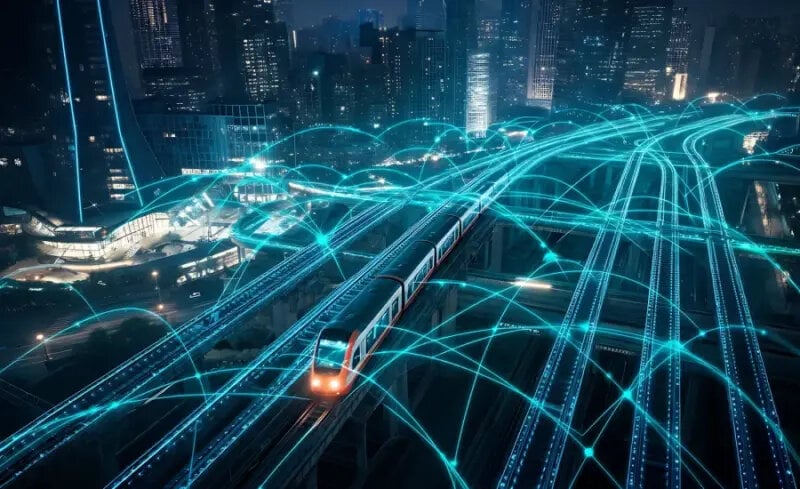railway-international.com
14
'25
Written on Modified on
Securing Rail Networks in a Connected Age: Cybersecurity Challenges & Solutions
Nomad Digital empowers rail operators with proactive cybersecurity services to secure connected fleets and shore systems against evolving threats.
www.nomad-digital.com

Emerging technologies, like automated signalling, IoT devices, and cloud-based systems, are revolutionising global rail networks and operation.
Digital services designed to enhance passenger experience and improve fleet operations are becoming more widespread. But, as systems become increasingly complex and interconnected, the larger the potential for cyber threats, and the result can be significant to transport systems and essential infrastructure. Service outages, data breaches, financial loss, and reputational damage are just some of the risks operators could face.
It’s not just rail facing this issue. Any public-facing system can be a target for hackers. Cyberattacks are growing in both frequency and complexity across all industries, largely due to the growing availability of sophisticated hacking toolkits. Even those with limited technical skills can launch disruptive attacks.
Threat Landscape
What Cyber Threats Does the Rail Industry Face?
Just some of the threats the rail industry can be at risk of include:
. Ransomware attacks: Hackers encrypt critical operational or business systems and demand payment for their release.
. Supply chain attacks: Third-party hardware or software integrated into the train network may carry hidden vulnerabilities or backdoors. Robust vetting, ongoing monitoring, and trusted supplier relationships are key to maintaining a secure ecosystem.
. Data breaches: Attacks targeting passenger data, ticketing information, or internal comms.
. Physical network intrusions: As seen during the 2024 Paris Olympics, attackers may target hardware and network infrastructure directly.
For deeper insight into the current and future cybersecurity challenges facing the rail industry, read our interview with Global Railway Review.
Industry Standards
Cybersecurity Standards in the Rail Industry
As technological solutions continue to be developed for the rail industry, as do security methods, standards, and guidelines. Some of the most notable frameworks include:
. NIS2 Directive (Network and Information Systems Directive 2): An EU regulation that applies to transport as well as other sectors like energy, healthcare, digital infrastructure, and public administration. It focuses on risk management and incident response and requires regular vulnerability assessments and reporting of significant incidents. The current NIS2 Directive builds on the original 2016 directive, introducing stricter security requirements and promoting stronger cross-border cooperation among EU member states.
. EN 62443 (also known as the ISA/IEC 62443): Originally developed for Industrial Control Systems, the EN 62443 isn’t rail-specific but is widely recognised across the industry. It offers a comprehensive framework covering system design, development, component supply chains, manufacturing, testing, deployment, and maintenance.
. EN 50701 (also known as TS 50701): Developed by a consortium of rail suppliers and operators, this is a rail-specific adaptation of EN 62443. It addresses the unique cybersecurity needs of rail transport systems.
Regulatory Spotlight
The EU Cyber Resilience Act (CRA)
Alongside these security frameworks, many governments are also working to address cyber threats in the transport industry. For instance, the EU has recently launched the Cyber Resilience Act that aims to improve cybersecurity standards in digital products marketed to the EU. This includes devices such as smartphones and laptops, as well as software and hardware components.
The CRA requires manufacturers to integrate security features from the outset — commonly known as “security by design” — and mandates that updates are made available to patch known vulnerabilities. For rail operators, these regulations mean greater responsibility and visibility around digital security. Forward-thinking operators are already assessing the impact of security updates on fleet safety. Others may need to refine their change management and upgrade processes to meet compliance requirements and reduce exposure to risk.
Nomad Digital’s Offering
Nomad Digital’s Cybersecurity Solutions
At Nomad Digital, we’re committed to helping train operators to proactively enhance their cyber resilience and threat response. Our security solutions include Nomad Secure, a Security-as-a-Service (SECaaS) solution designed to tackle transport cybersecurity.
Our solution provides continuous monitoring of both on‑train and shoreside systems, using a robust alert system to detect actual or suspected cyber threats in real time. If suspicious activity is identified, Nomad Secure quickly highlights the issue, enabling rapid incident response.
We also deliver custom-built strategies to help transport operators align with industry standards, enhance their security readiness, and streamline their ability to respond to incidents through structured, ongoing planning.
As rail networks become increasingly connected and digitally advanced, cybersecurity must be a priority. By adopting proactive cybersecurity strategies, leveraging trusted partners, and aligning with evolving industry standards, operators can build digital resilience while continuing to deliver safe, reliable journeys. At Nomad Digital, we’re here to support that journey. Get in touch today to find out how we can help you.
www.nomad-digital.com

